Samsung Galaxy S 4 Qi Wireless Charging Pad and Cover - Mini Review
by Brian Klug on July 13, 2013 8:15 PM EST- Posted in
- Smartphones
- Samsung
- Mobile
- wireless
- samsung galaxy s 4
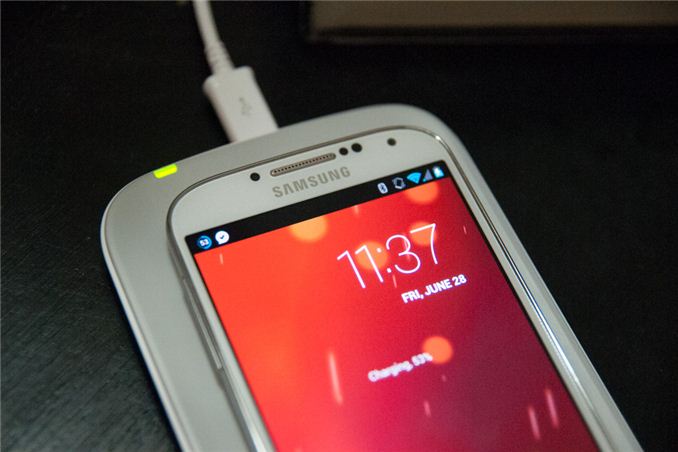
For a while now, wireless charging has been slowly gaining momentum, and one of the phones that includes support is Samsung’s Galaxy S 4 (SGS4). For the past week, I’ve been using a review unit of Samsung’s wireless charging accessory kit for the aforementioned smartphone which includes both a Qi compatible wireless charging pad and battery back.
Using the wireless charging accessory is simple – you remove the stock battery back, snap on the new one, and plug the wireless charging pad into the Samsung charger that originally shipped with the phone. This last point is critical, as the wireless charging pad requires the 2 amp charger that Samsung supplies with the SGS4. I’ve touched on charging in the past before, but this charger includes the 1.2 V signaling across the D+ and D- pins which signals 2 amp (tablet-class) compatible charging to Samsung devices, like the charging pad. Using a normal BC 1.2 compatible charger won’t work, as that specification only stipulates up to 1.5 amp delivery on its dedicated charging port.
Of course, since the charging pad and SGS4 are Qi compliant, you can obviously use a variety of wireless charging pads that implement that standard to charge the device. I tested on my go-to Energizer dual position Qi charger, and the SGS4 with wireless charging back worked as expected.
The only downside with the wireless charging back is that it does add noticeably to the thickness of the SGS4. I broke out my calipers and measured an increase in thickness of just over 1.7 mm with the wireless charging back attached instead of the stock one.
| Samsung Galaxy S 4 Charging Back Thickness (Measured) | ||||
| SGS4 No Battery Cover | 7.20 mm | |||
| SGS4 Stock Battery Cover | 7.94 mm | |||
| SGS4 Wireless Charging Battery Cover | 9.70 mm | |||
It’s not a huge difference, but it is noticeable. I suppose one benefit to this added thickness is that the front vertex of the camera no longer is the thickest part of the SGS4, which adds a bit of protection if you’re laying it back-first, on a flat surface.
The back of the wireless charging back has two sets of two contact pads that mate up with the inside of the SGS4. I tested with my DMM and on one set you get a steady 5 volts when aligned with the charging pad, on the other nothing. I strongly suspect the wireless charging downstream controller is in this battery back, so Samsung can keep their handsets relatively standards-agnostic and just ship whatever wireless charging standard back they want. In addition this obviously would help keep the BOM cost lower on the device and avoids shipping controllers that customers might not use.
So the big last question is – how well does it work and how fast does it charge the SGS4? For a while now I’ve been measuring charge times for devices, something I believe enters just as strongly into the battery and power side of a device as its time through our battery life tests. The SGS4 is already one of the fastest charging devices out there considering its battery size thanks to the speedy (albeit proprietary) 2 amp charging signaling. Because there’s overhead involved with wireless charging, this obviously gets diminished with the wireless charger. I measured a fully drained to fully charged time of 3.922 hours with the wireless charging back attached and Samsung’s charging pad connected to the 2 amp charger.
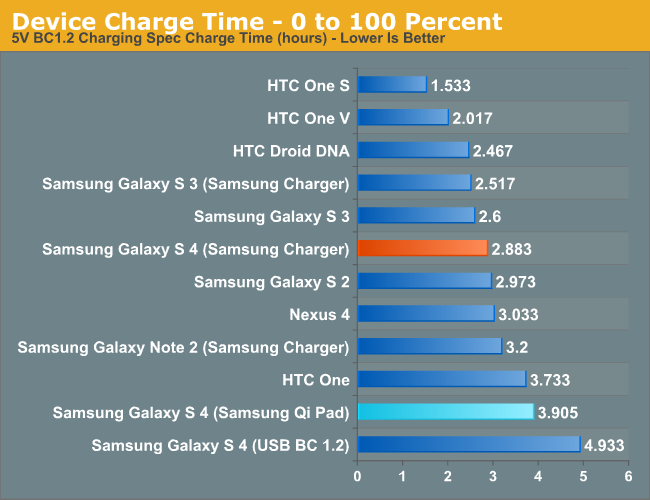
That’s a measurable and obvious increase in time over the dedicated 2 amp charger connected over USB (2.883 hours, so about 35 percent longer charge time), but that’s the price you pay for the added convenience of not having to plug anything in. On the device side wireless charging is implemented properly, you see the wireless charging splash screen while charging you see the wireless charging logo with the device off, and wireless charging indicators in Android.
As I mentioned earlier, wireless charging is slowly gaining momentum. It isn’t everywhere, but it’s starting to become more and more of a given instead of a one-off. I’m still waiting for my Qi-compliant nightstand table from IKEA, or charging pads at my local cafe, but who knows when that’ll finally (if ever) happen. Obviously uptake for Samsung would be faster were the SGS4 compatible without the need for an accessory back and charging pad, but the tradeoff would obviously be a thicker phone. I’m pleased with the wireless charging accessory, it works like it’s supposed to, and wireless charging definitely is an added convenience after you’ve used it for a while. The wireless charging pad from Samsung runs for $49, and the wireless charging cover runs $39, both of which are a little steep but still around what I would expect for the pad. Of course the nice thing about Qi is that after you have the cover, you can always shop around for a pad that suits you.
Source: Samsung (Wireless Charging Pad) (Wireless Charging Cover)


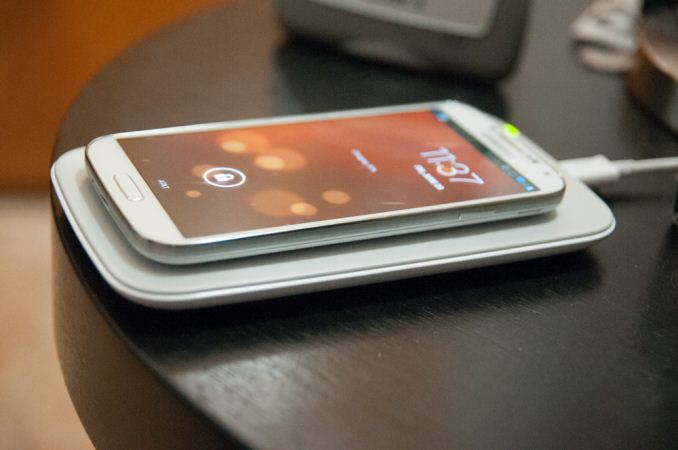
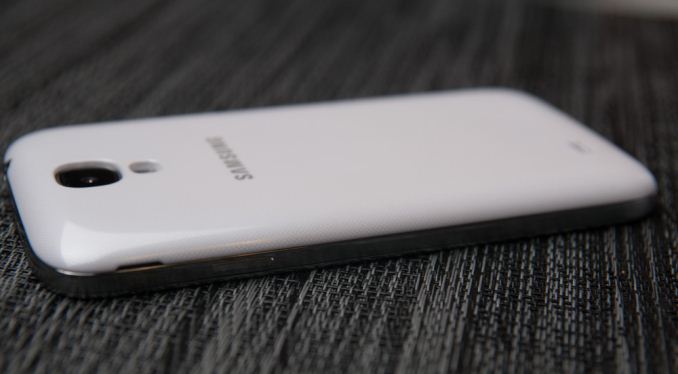
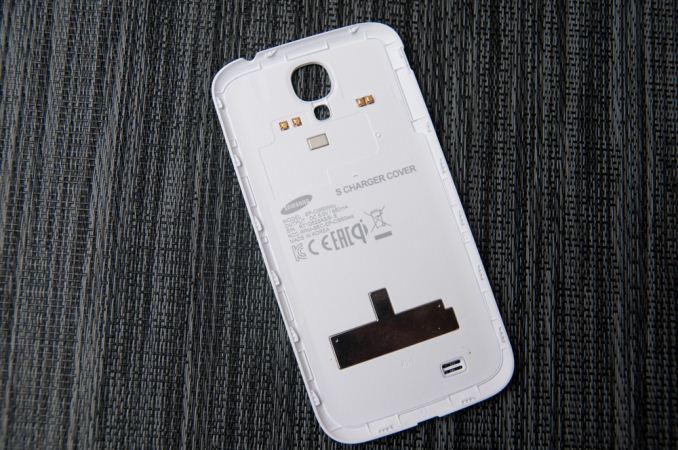














33 Comments
View All Comments
sergeant1975 - Saturday, July 13, 2013 - link
I appreciate the info on the replacement back cover the allows Qi inductive charging, but there is a much cheaper way to achieve wireless charging. I have had a qi sticker that fits under the factory back cover and adds no bulk. It cost like $25 bucks and I can still use all my covers. If you buy the new larger back cover your cases no longer fit. There are several different manufacturers making these on Amazon.BugblatterIII - Sunday, July 14, 2013 - link
I use one of those on my S3; got both the sticker and the pad separately on ebay.Works nicely under the original cover; it makes the back bulge very slightly but doesn't cause a problem with my cover.
The phone gets very warm on the pad though; not so keen on that and makes me wonder about wasted energy. I'd be interested to see the energy efficiency compared to wired charging.
noeldillabough - Sunday, July 14, 2013 - link
Me too! Does it use substantially more power to charge your device? After a year is it noticeable on cost? Does the pad use power when not charging? All probably marginal but just in case...Łukasz Markiewicz - Sunday, July 14, 2013 - link
Curious about this.Since Brian hasn't mentioned this in the review, I'm guessing the GS4 does not heat up noticeably with the qi kit.
DanNeely - Monday, July 15, 2013 - link
The fact that it takes 1/3rd longer to charge despite the same amount of power going into the charger implies that the wireless charger is only 75% as efficient as the wired one. For a full daily charge at typical US energy prices the extra power will cost significantly less than $1/year. (10c/kwk is roughly equivalent to $1/wattyear. And 10W of power for one hour a day is ~.4W average load; for ~40c/year).Waylo - Monday, July 15, 2013 - link
There are actually several cases that will still fit, mostly of the TPU variety. The Diztronic TPU case as well as the Spigen Neo Hybrid do. They may be 'stretched' a bit, but they serve their purposes still.shanesaccount - Tuesday, July 16, 2013 - link
What was the URL for the sticker that you got on Amazon?
Did it make the regular cover "bulge" slightly like other reviews I've seen of the kind you're talking about?
Thanks!
feihu989 - Sunday, November 3, 2013 - link
The more economic way would be a card that insert into the phone and put between the case and battery, here is where we could get with both transmitter pad and receiver on Amazon: http://www.amazon.com/dp/B00DRB2ENKTotally_Rad - Wednesday, February 26, 2014 - link
You can't use nfc with the sticker, wiseass!snajk138 - Sunday, July 14, 2013 - link
For me the charging time isn't that important. I charge at night so wether it takes two or six hours doesn't matter cause I'm asleep in my bed anyway. What does matter is how much juice I can get in a few minutes when the battery is almost dead